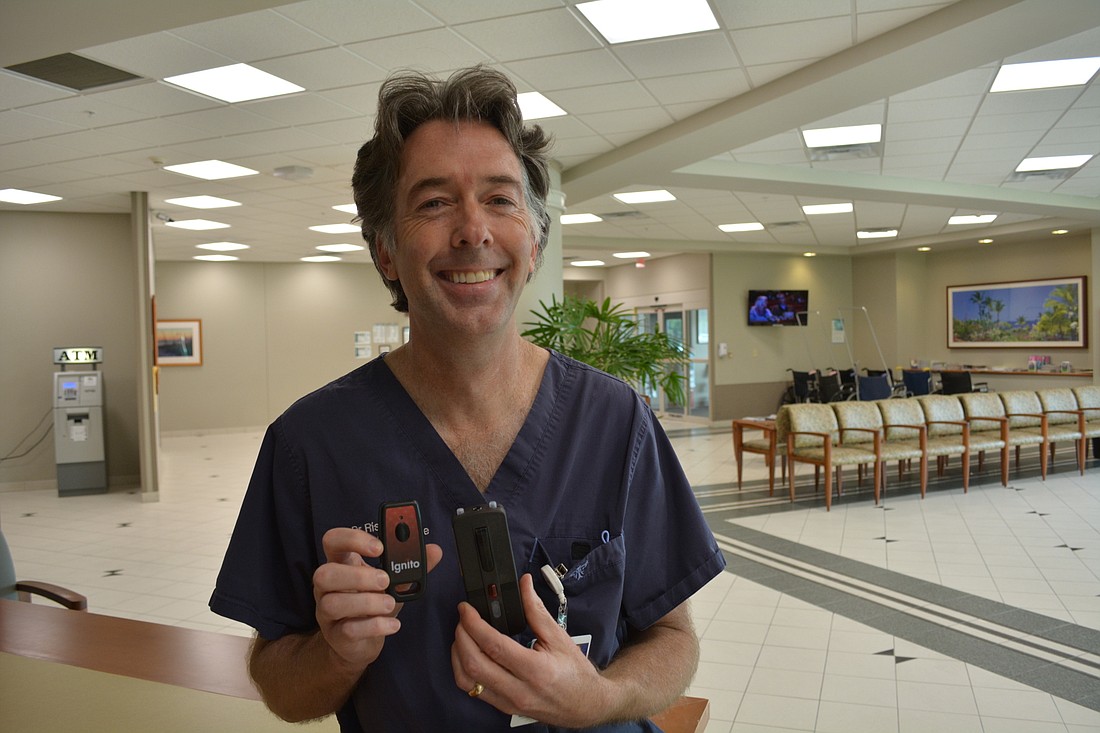- May 8, 2024
-
-
Loading

Loading

Dr. Andrew Risner admits a trip to the fireworks store is like a day in paradise for him.
But as an emergency room physician at Lakewood Ranch Medical Center, the Sarasota resident also knows safety comes first.
So five years ago, Risner began developing Ignito, a remote-control system that allows individuals to set off fireworks from up to 60 feet away. Consumers place the wick of the firework into a base, walk away and then press a button on a separate control. A burner inside the device lights the wick and sets the firework off from a safe distance.
“It gets up to about 800 degrees Fahrenheit inside,” Risner said.
Risner earned his bachelor’s degree in engineering, before pursuing medicine. He found family practice a little too monotonous for his liking, and instead decided to focus on emergency room medicine, where he could treat everything from blood pressure issues to trauma.
It was while treating a patient in the emergency room one day that he came up with the idea for Ignito. The patient had a blood blister under his fingernail.
“The treatment is to burn a hole in the nail,” said Risner, who added doing so allows the blood to drain and relieves the pressure.
To do so, physicians use a tool that looks much like a pen, but the end burns hot. Risner put on his engineer’s thinking cap. When he got home, he took apart a radio-controlled motorcycle his daughter, Sunny, had given him.
He disassembled it, figuring out which of two wires made the back wheels spin. Then, he placed the wires into pen-like tool and when the antenna received signal, the circuit was closed and the tip of the pen glowed red hot.
“If nothing else, I really impressed my wife,” Risner said with a smile.
Risner brought the idea to a patent lawyer, who referred him to an engineer, Lisa Fitzgerald. She gave him the first prototype about four months later.
“Her job was to design it and my job was to test it until it broke, then take it back to her,” Risner said. “That took a good three years.”
They had to figure out which plastics could tolerate temperatures of 800 degrees Fahrenheit inside, and how to keep ash from building up and breaking the circuit after multiple uses, among other engineering problems.
The product, which is good for more than 50 uses per set of batteries or 300 total uses overall, debuted at two fireworks stores in Tampa July 2014. It went on amazon.com last Fourth of July. Although only 120 Ignitos have sold, Risner hopes the product will become popular for providing consumers with a safer way of using fireworks. He said even for smaller fireworks, it’s recommended to be as far away as possible, at least 20 feet for fountain-style fireworks and 40 feet from aerial fireworks.
“That’s why I made this,” Risner said.
There are as many as 10,500 injuries from fireworks per year treated in emergency rooms in the United States — and that’s just the figure actually reported to Consumer Product Safety Commission. Risner said the actual number is more.
“I’ll feel good as an ER doctor to see those injuries go down,” Risner said.
FIREWORKS STATISTICS:
2014 Fireworks statistics, the most current available from the U.S. Consumer Product Safety Commission:
• Children younger than 15 years of age accounted for 35% of injuries. Nearly half of the estimated emergency department-treated, fireworks-related injuries were to individuals younger than 20 years of age.
• Children 5 to 9 years of age had the highest estimated rate of emergency department-treated fireworks-related injuries (5.2 injuries per 100,000 people).
• There were an estimated 1,400 emergency department-treated injuries associated with sparklers and 100 with bottle rockets.
• There were an estimated 1,400 emergency department-treated injuries associated with firecrackers.
• The parts of the body most often injured were hands and fingers (an estimated 36%); head, face, and ears (an estimated 19%); eyes (an estimated 19%); legs (an estimated 10%); and arms (an estimated 5%).
• Fifty-four percent of the emergency department-treated injuries were burns. Burns were the most common injury to all parts of the body, except the eyes, where contusions, lacerations, and foreign bodies in the eyes occurred more frequently.
• Approximately 83% of the victims were treated at the hospital emergency department and then released. An estimated 14% of patients were treated and transferred to another hospital or admitted to the hospital.